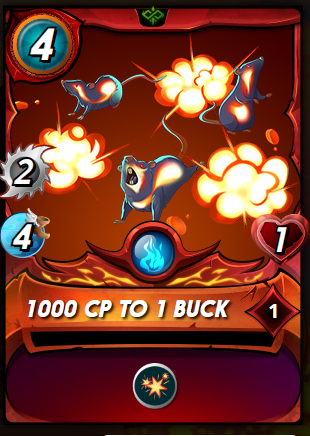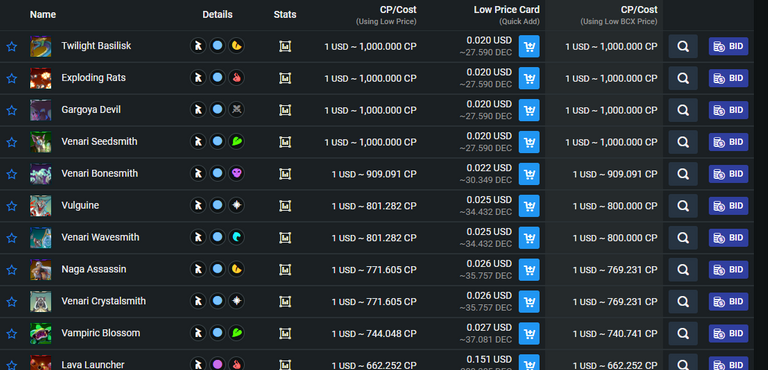How 1,000 Collection Power to $1 Relates and Doesn't Relate to the Crypto Crash
It's an unusual moment in Splinterlands card pricing.

If it were the old days, circa 4 months ago, this would not be imaginable. One would see these prices as unimaginable, but this inevitable point has been reached and these prices could fall even further. It is a good time to accumulate the cards, combine the cards (effectively burning them), and use them. These prices are not forever and when they go out-of-print, the market will tighten considerably as in-print rewards begin the devaluation process.

The Splinterlands Development Team's Rewards Gambit
With more Rewards cards and more cards awarded to each player per day and per season, the cards would be in-print for a shorter cycle of time with greater participation. It rewards participation in the game and ecosystem. Greater card variety will result in participants being more excited over their hauls and coming back for more.
There were a few things that the team accomplished by changing the Rewards structure:
- It was an opportunity to sell out Chaos Legion packs faster.
- It was an opportunity to distribute all of the stale Chaos Legion in-print Rewards without actually burning the cards. These Rewards cards only had roughly 50% of the cards printed after 9 months and at the rate they were going, it could have taken 1 1/2 years to burn through them all, which did not do much to improve their value in 2023 and beyond.
- With the second set of in-print Rewards cards, it provided the team with an opportunity to see how fast they can go through the cards with the present audience and make projections going forward with future editions.
We could see seasonal runs of Rewards cards that may not necessarily be seasonal in name, but in nature, have such qualities. This could be an intriguing addition of variety that hooks players into the game and could serve as a promotional vehicle for business partnerships (@aggroed we believe in you).
Crypto Crash
A few factors have caused the recent cryptocurrency crash. A gleeful mainstream media (bipartisan) have cheered on this crash while many lost a lot of money in cryptocurrencies they did not understand and in arrangements they failed to understand.
Collateral Damage
Well-run and prudent operations as well as discerning investors and project owners are collateral damage in this cryptocurrency debacle. However, this is not what mainstream outlets choose to cover. Instead, the broad brush is painted and everyone loses. It's like Index Funds, where any sort of an overall market sentiment can impact industries and companies that may be operating poorly or rather well in a given environment. Everyone is along for the ride.
Negative sentiment applies to all and everyone falls.
EU Regulation
The European Union loves to regulate EVERYTHING. It's sort of like the United States and the culture of litigation being baked into the cake of the cost of everything.
A sweeping set of regulations are coming for all 27 European Union countries and they are going to make it tougher to hold, buy, sell, spend, create, and invest in cryptocurrencies. From environmental impacts to ending anonymity of accounts, the European Commission is going to give the European Central Bank's competition a set of operational barriers that will discourage privatized, decentralized digital currency.
Federal Reserve Raising Interest Rates
Federal Reserve Chairman Jerome Powell raised interest rates by .75% on June 15 with the intent to fight inflation and future interest rates could be rising considerably over the course of the year in the United States. With many invoking former Federal Reserve Chairman Paul Volcker's name in describing the interest hikes that may be necessary to undo the damage that a decade of Quantitative Easing, interest rates set at zero percent, and zero reserve banking have wrought.
High interest rates make the centralized fiat currency more competitive when it comes to holding it and making bank deposits (lending to banks).
Centralized Finance
Many people learned "not your keys, not your crypto" is not just a saying. Leaving cryptocurrencies in exchanges and lending money to financial institutions (i.e. Celsius) at high interest rates like they would at a bank because savings account interest rates are extremely low is a risky endeavor. These financial institutions offered high returns for uninsured custodial accounts and the cryptocurrencies that investors held were never truly in their possession.
High Volatility Chasers and Idiots
Many people were chasing high returns to beat market returns or even get rich quick and this is never a good recipe. Cryptocurrency, blockchain technology, and the whole idea of a decentralized internet is not supposed to be a gold mine. The objective is remove inefficiencies, empower users, promote transparency, and generate tokens that are supposed to be used. It's supposed to be an alternative.
Cryptocurrencies were/are not meant to be high volatility assets that were bought and sold for fiat currency. This gives fiat currencies unintended power. Buy cryptocurrencies, accept cryptocurrencies, invest with cryptocurrencies, and borrow with cryptocurrencies.
Cryptocurrencies give fiat currencies private, digital competition. The idea of singular currencies dominating a country is relatively new in a historical sense as banks issued private currencies and businesses, banks, and individuals held and accepted multiple sovereign currencies.
HODL is the strategy of the person who wants to convert their digital assets back to fiat currency when their position is unfavorable. Either the assets are used like a currency and the Non-Fungible Tokens are used in a meaningful way or they are not. Plain and simple. This leads into the next problem.
Gerontocracy and Restrictions Stifle Adoption
The bright future of cryptocurrency adoption will probably be found in Latin America and Southeast Asia. This is a tough reality to confront. However, consider the following.
The European Union, United Kingdom, Australia, New Zealand, Canada, and the United States comprise what is known as "The West". "The West" is aging rapidly and birth rates are falling considerably. Younger individuals are not as inclined to be involved politically and do not have the capital to make an impact. Younger individuals, while they are more technologically inclined, consume more rather than produce. Older individuals are more likely to own and manage businesses of all sizes, they also do not have the tolerance for risk that younger individuals have. The refusal to take on risk and embrace changes lead to lack of adoption of cryptocurrencies.
China and India have more restrictive, centralized regimes that are generally anti-cryptocurrency.
In Latin America and Southeast Asia, the populace is young enough and more willing to take on change.
Currency issues in Latin America have conditioned people to using multiple currencies. Histories of defaults and currency devaluation haunt many in the region. Cryptocurrency provides a way for Brazilians, Venezuelans, and Argentinians to conduct business in a way that does not involve their crooked and incompetent central planners.
Seasonality Plays a Role with Splinterlands
Splinterlands can technically be played everywhere. Play it at the beach or on a boat, waiting on a 120 minute line for Splash Mountain at Walt Disney World, at a bar when things get really boring in a night, at a baseball game or at your own home. However, most people tend to play the game at home. Being home means being inside and during the warmer months in the Northern Hemisphere many choose to go outside and enjoy the time while they can. For most in the Northern Hemisphere, once it turns to October, people are going back inside again.
What are people doing when they are back inside because it is too cold to do fun Summer activities? They're playing Splinterlands. It's not terribly surprising that Splinterlands' last big run-up happened to take place in the Fall and start of the Winter season.
It is very possible that the current Rewards card prices are a result of high print rates, high amounts of cards being released due to the increased number of loot chests, crypto sentiment, and seasonal lack of demand. The actual player base (not bot farms) should increase when the weather gets colder.
Now is the time?
The following is not financial advice, do your own homework, please.
If you are looking to build up your deck in Splinterlands, now is the time to consider making moves. Creating new accounts, buying assets, purchasing a Node License or getting involved in other different ways with the ecosystem would be considerations.
Might as well buy from the bot farmers who play a role in driving down the prices.
Special Messages...
If you are the @splinterlands marketing team. Now is the time to re-think that marketing strategy. Spellbook sales are abysmal and most of them are alts or bot accounts. Time to re-think who the target audience(s) are because this ecosystem should be even more dynamic and lucrative.
If you are attending Splinterfest 2022: Use it as an opportunity to network, have fun, and come up with creative ways to bring the ecosystem to your area.